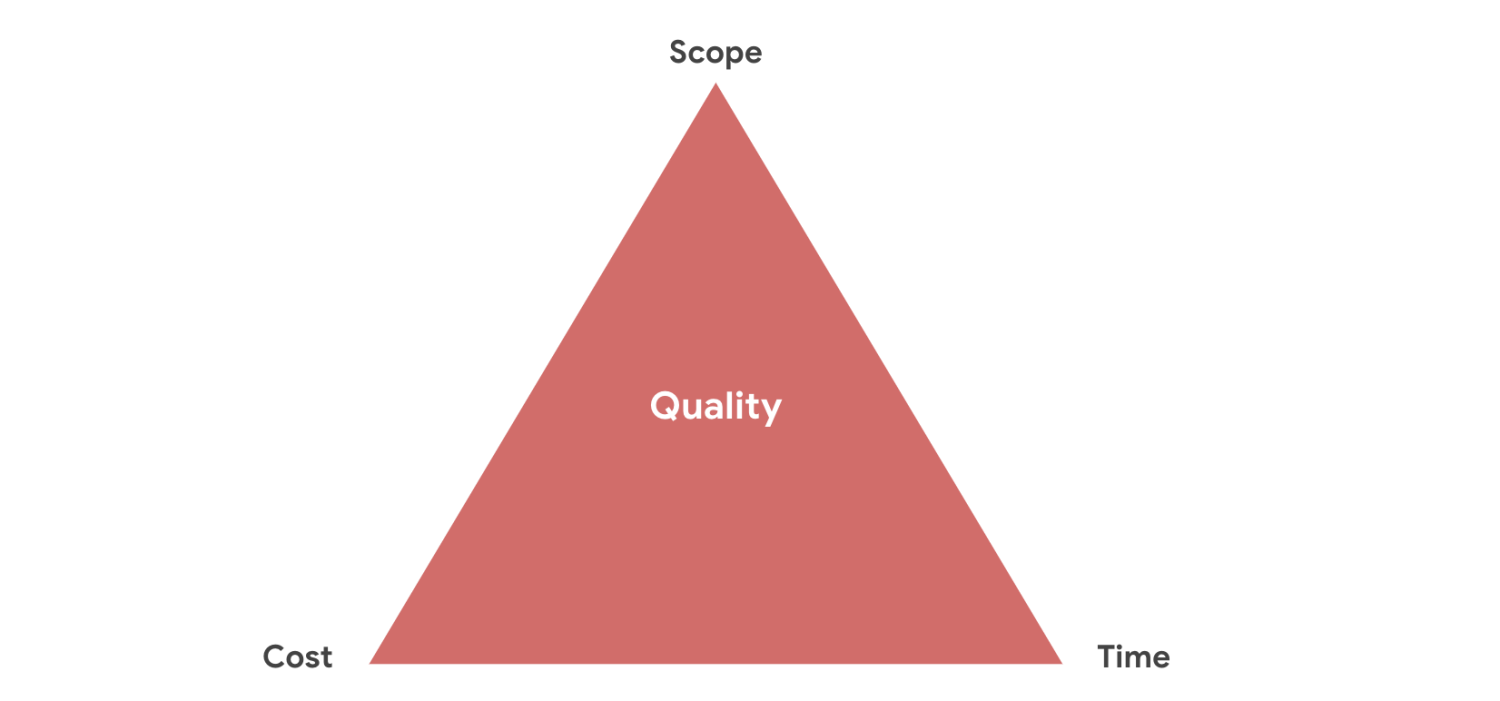What Is the Project Management Triangle?
The project management triangle is a visual representation of the relationship between the scope, time, and budget constraints in project management.
![[Featured Image] A product manager is presenting the project management triangle.](https://d3njjcbhbojbot.cloudfront.net/api/utilities/v1/imageproxy/https://images.ctfassets.net/wp1lcwdav1p1/4dYTw4ufSLxlTTBH7xSjmi/ce6aca71f1c2016c2564a3406c63f3bb/w3Lv61lL.jpeg?w=1500&h=680&q=60&fit=fill&f=faces&fm=jpg&fl=progressive&auto=format%2Ccompress&dpr=1&w=1000)
Project management triangle definition
The project management triangle is a model that shows how the balance between three constraints—scope, time, and budget—affects project quality. Affecting one constraint will mean adjusting one or both of the others to maintain quality. It’s also called the triple constraint model or the iron triangle. Project managers must oversee all three of these constraints to complete a project successfully.
Scope: Scope refers to the deliverables and tasks a team must complete to achieve the project’s goals. The scope might change if stakeholders decide mid-project that they want to adjust a product or add another product entirely.
Cost: Project cost is the total amount of money required to complete a project. This is also called the budget. Costs might include salaries for employees and money for equipment, tools, office space, and other resources. Adding new members to a team or increasing the time it takes to complete a project can impact the cost.
Time: Time is how long it takes to complete tasks in a project and the project itself. This constraint is also called the schedule. An expanded scope can increase timelines. So can a decreased budget. For example, if a team member is removed due to budget constraints, it can take longer to complete a project.
Project management triangle example
Let's say you need to expand the scope of a project. This might mean extending the project's original schedule or increasing the budget so as not to affect the quality of the output. Likewise, shortening the schedule to meet an earlier deadline might mean increasing the budget or tightening the scope. Need to absolutely reduce the budget and timeline without changing the scope? Then, the triangle might have to shrink—meaning the quality of the product might be reduced.

Some models show an enhanced project management “triangle” with six constraints [1]:
Scope
Cost
Time
Benefit (sometimes called “resources”)
Risk
Quality
This model is sometimes depicted as a six-point star made from two overlapping triangles.
What is the project management triangle used for?
The project management triangle is a useful concept for project managers for the following reasons:
It helps to see how changing one project constraint will affect other constraints. If you change the scope of a product you’re hoping to launch, you know that either the budget needs to increase, or the timeline needs to be extended (or both).
It can help mitigate risks. Say your project to launch a new piece of software has a hard deadline, and you’re worried your engineers will fall behind. You can ask stakeholders for a contingency budget in case you need to hire another engineer to help complete tasks.
It can clarify priorities in a project. Does your project have a hard deadline, a strict budget, or precise deliverable requirements? Knowing this can give you a better idea of what a successful project will look like.
Managing the project management triangle
Here are concrete ways to balance the constraints of the project management triangle.
Communicate with stakeholders: Speak with stakeholders to know what is acceptable change and which constraints should be prioritized. Is the deadline immovable or is the budget strict? This will give you an idea of how the project can adapt should changes become necessary. This is a crucial step in the initial stages of the project, but frequent communication should also happen throughout the project.
Establish risk management processes: Planning for risks should be a step baked into your project management process to prevent scope creep and stay within budget and on schedule. Identify risks, then establish a plan to mitigate each.
Create change-management processes: Change is often inevitable. Having a change-management process creates a structured change-approval process. This ensures the team is aware of changes as they happen and how they impact the project. This can also reduce scope creep.
Choose a methodology based on constraints: You may adopt a project management methodology based on your constraints. Projects that face strict constraints are often managed through Waterfall-type approaches. An agile method like Scrum might be more fitting if you need more flexibility. Projects where inefficiencies need to be minimized as much as possible can benefit from a Lean approach.
Getting started in project management
Mastering the project management triangle is one of the many fundamental concepts aspiring project managers should have under their belt. If you’re looking for a place to learn other project management essentials, check out the Google Project Management: Professional Certificate.
Frequently asked questions (FAQ)
The project management triangle helps to illustrate the relationship between project constraints. It can also help reduce project risk or provide insight into how to deal with them if they happen. The project management triangle can also help establish what the priorities are in a project.
The project management lifecycle has four stages: initiating, planning, executing, and closing. Some resources list five phases, adding “monitoring and controlling” to this list.
Many factors can cause scope creep, including a poorly defined scope, lack of communication between stakeholders and the team, unclear priorities, too many dependencies, and others.
Article sources
Project Management Institute. "Six (yes six!) constraints: An enhanced model for project control, https://www.pmi.org/learning/library/six-constraints-enhanced-model-project-control-7294." Accessed May 8, 2024.
Coursera Staff
Editorial Team
Coursera’s editorial team is comprised of highly experienced professional editors, writers, and fact...
This content has been made available for informational purposes only. Learners are advised to conduct additional research to ensure that courses and other credentials pursued meet their personal, professional, and financial goals.